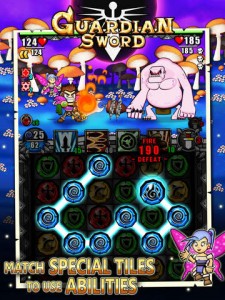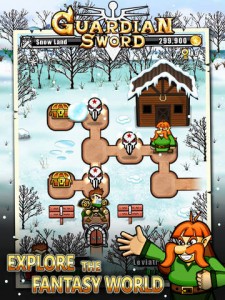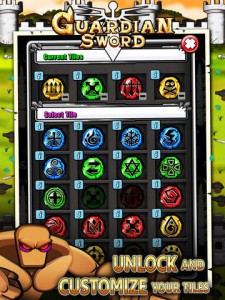One day as he was sleeping in the forest, the swordsman Guts — whom has nothing to do with the anime: Berserk — wakes up and decides that he should go and find the legendary Guardian Sword, and afterwards use it to take over the world before someone else can. Not exactly the noblest of goals — I will admit — and yet, as Guts slowly bumbles through his plans, it quickly turns out that the world actually does need saving (and I don’t mean from Guts himself, for it seems that some far worse people want to take over as well). Thus goes the opening premise to the aptly named Guardian Sword (out now, $2.99 FREE for a Limited Time Only!), an enthralling blend of Puzzle and RPG mechanics from Picsoft’s talented team of Bangkok dwelling developers.
 The quickest analogy one could make to explain the game play of Guardian Sword would be with Bookworm Adventures, except that your goal here isn’t just to see how long a word you can spell. At the top of the screen you’ll see an animated representation of Guts’ battle against whomever his current opponent is, and at the bottom of the screen you’ll find the puzzle field that determines whichever possible actions Guts can take next. Performing any possible action will require you to draw a line across three or more tiles of the same color (although the line drawn doesn’t exactly have to be even remotely straight), with the color of tiles used determining which sort of action Guts executes next.
The quickest analogy one could make to explain the game play of Guardian Sword would be with Bookworm Adventures, except that your goal here isn’t just to see how long a word you can spell. At the top of the screen you’ll see an animated representation of Guts’ battle against whomever his current opponent is, and at the bottom of the screen you’ll find the puzzle field that determines whichever possible actions Guts can take next. Performing any possible action will require you to draw a line across three or more tiles of the same color (although the line drawn doesn’t exactly have to be even remotely straight), with the color of tiles used determining which sort of action Guts executes next.
Red tiles instruct Guts to swing his massive blade, which is highly damaging; Yellow tiles fire his crossbow, which may be used to hit aerial targets (but is otherwise weaker); Green tiles order Guts to defend against attacks; and Blue tiles restore his mana supply. The number of matching tiles used at once will have an additive effect upon the final result, with the current result achieved being displayed as you drag your finger around (and you may always move your finger backwards in order to undo/redraw any part). This way you’ll always know precisely how many damage tiles you’ll need in order to achieve a kill shot (as well as avoid using too few, getting no result at all), or even how much damage you can expect to receive with the current number of green tiles selected.
Once you’ve drawn a line — however crooked it may be — all of the tiles in that line will be removed from the puzzle field; after which all of the tiles situated above the new gap will drop down, and Guts will perform which ever action those tiles represented. As Guardian Sword’s playing field is always 100% filled to the brim with tiles, new tiles — chosen entirely at random — will then rain down to fill the field’s freshly created empty spaces. Although you can’t necessarily control which colors will ever spawn in next, some of your special abilities — which I’ll be covering further down — can be used to modify the tiles already on the board (such as simultaneously turning all red tiles into yellow ones).
 Anyways, listed for each enemy will always be their current move — as well as whatever they’ll use afterwards — plus however long it’ll take them to pull it off (moves followed by a 1 will be used immediately, whereas higher numbers will count down each round). Tapping on either of these moves will list for you how much damage they’ll do — alongside whether that damage is physical/magical in nature, and also if any status effects will be inflicted — or if the attack will affect any of the tiles currently on the puzzle board. Furthermore, tapping directly upon an enemy will reveal their defense level — as no attack will ever be effective until you’re at least inflicting more damage than this value — as well as if they have any additional passive perks (such as being resistant to magical damage).
Anyways, listed for each enemy will always be their current move — as well as whatever they’ll use afterwards — plus however long it’ll take them to pull it off (moves followed by a 1 will be used immediately, whereas higher numbers will count down each round). Tapping on either of these moves will list for you how much damage they’ll do — alongside whether that damage is physical/magical in nature, and also if any status effects will be inflicted — or if the attack will affect any of the tiles currently on the puzzle board. Furthermore, tapping directly upon an enemy will reveal their defense level — as no attack will ever be effective until you’re at least inflicting more damage than this value — as well as if they have any additional passive perks (such as being resistant to magical damage).
While this might sound simple enough at first — with players attacking whenever they can make damage-chains of a sufficient length, and defending just before an incoming attack lands — an additional layer of strategy is added because of the entire puzzle board aspect. For instance: whenever an enemy is prepping an attack of massive proportions — which is thankfully indicated by a skull icon — you’re going to need to take some precautions to ensure that you’re ready, as a mere three-shield chain will likely fail to keep you alive. You’ll either need to clean up the playing field in an attempt to maximize the number of green shield tiles touching each other, or you’ll need to quickly amass enough mana to activate your costly magical perfect-defense ability.
Abilities, of which you may have up to four equipped at any given moment, are special techniques — which can freely be used whenever you wish, assuming they aren’t currently in cool down — that require you to expend your stored up mana in order to activate them. These let you do things such as shuffle the board, force flying enemies into sword range, perfectly dodge ground attacks, forbid enemies to dodge attacks, as well as perform a plethora of massively damaging special attacks (some of which even cause status effects). Status effects — by the way — are only applied when the attack including them isn’t somehow perfectly negated out, and then only if the target in question doesn’t somehow have a passive immunity against that particular effect.
 Special abilities — however — are not the only equipable items in Guardian Sword, and you’ll additionally be able to bring along four passive and active tiles of your choosing into every battle (that’s specifically both four actives and four passives at the same time). The active tiles have a chance of appearing any time a normal tile of the same color would have spawned in, and — despite having a clearly different picture on their face — can otherwise be used as part of any chain consisting of other tiles of the same specific color. Picking up a magical cross in the midst of your shield-combo allows you to block magic attacks also, picking up poison will allow a successful crossbow strike to poison your foe, whereas a fire tile will cause your entire mana-chain to become a magical strike instead.
Special abilities — however — are not the only equipable items in Guardian Sword, and you’ll additionally be able to bring along four passive and active tiles of your choosing into every battle (that’s specifically both four actives and four passives at the same time). The active tiles have a chance of appearing any time a normal tile of the same color would have spawned in, and — despite having a clearly different picture on their face — can otherwise be used as part of any chain consisting of other tiles of the same specific color. Picking up a magical cross in the midst of your shield-combo allows you to block magic attacks also, picking up poison will allow a successful crossbow strike to poison your foe, whereas a fire tile will cause your entire mana-chain to become a magical strike instead.
Your passive tiles — unlike the special tiles — are always in effect, adding small bonuses to Guts without you needing to do anything other than having them equipped before a battle begins. These include perks such as increases to your health and magic pools, increases to your crit chance, perfect immunity to various status effects, increasing the rate at which you earn experience, making items more likely to drop from defeated foes, and so forth. Although these passive tiles aren’t nearly as important to carefully match against the foes you’ll be facing, perfect immunity against sleep — or even stun — can be an absolute life saver whenever everyone in the area is fully determined to inflict that effect upon you.
Finally there is Guts’ immediate equipment, which — beyond changing how he appears in combat and walking around — can additionally empower him to better tackle his many foes. Players can equip better swords and crossbows to do more damage with their respective attacks, better armor to enhance their pool of available hit points, scarves to increase the size of their mana pool, and shields to make blocking even more effective. Now — unlike everything else I’ve mentioned thus far — each new piece of equipment is inherently superior to the one before it, meaning that the only time you’ll ever fiddle with your gear is when you’re a high enough level to buy the next available armament.
 Now while your fallen foes certainly drop gold upon dying — and sometimes even valuable items — Guardian Sword wouldn’t be a proper RPG without any leveling, and the game has that front covered as well. Upon leveling up you’ll find that none of your stats have improved yet, since you’ll instead acquire ability points that can be spent to increase your proficiency with: health, mana, defense, and weapon-specific attack power. Whereas your level within a specific stat will — interestingly — control the base value of that skill, your equipped gear will apply an ever increasingly larger multiplier on top of your existing stat-derived base value.
Now while your fallen foes certainly drop gold upon dying — and sometimes even valuable items — Guardian Sword wouldn’t be a proper RPG without any leveling, and the game has that front covered as well. Upon leveling up you’ll find that none of your stats have improved yet, since you’ll instead acquire ability points that can be spent to increase your proficiency with: health, mana, defense, and weapon-specific attack power. Whereas your level within a specific stat will — interestingly — control the base value of that skill, your equipped gear will apply an ever increasingly larger multiplier on top of your existing stat-derived base value.
Furthermore — when outside of combat — you can move Guts around his world one square at time, with the location of enemies clearly marked (and these enemies return only either after deliberate actions, or after you leave an area and then return again afterwards). Tapping on Guts will either enable you to examine whatever he’s standing next to, or select from his ever growing cadre of tools to see if he can do something to the object in question: light torches with a flare, break walls with a hammer, and other such things. Although Guardian Sword’s walking mechanics are perfectly functional all on their own, it can sometimes be rather annoying when the game requires to retread old areas — hitting up every last foe along the way — because you just found a new tool to poke around with.
I really can’t over stress just how much backtracking Guardian Sword truly contains, despite the fact the game claims that helpful teleport pads exist to expedite returning to old locales (at best they’ll only ever start you a few screens away from your destination). More than once I felt as though this game really needed Pawdugan’s Backtrack Song playing in the background, a fact not helped in the slightest by there being absolutely no way of bypassing even one of the enemies that respawn whenever you revisit any place. The worst offender of this backtracking sensation — however — didn’t even involve returning to earlier locales, and instead involved a puzzle with four torches that needed to be lit in the right order (and any mistake would instantly force-respawn all the enemies).
 Also not helping your mood during Guardian Sword is going to be the fact that Picsoft would immensely appreciate it if you’d gave extra money; seeing as how purchased gems can be used to reforge your gear, or even revive you in the middle of a dire boss fight. Furthermore — once you get far enough into the story — you can even IAP acquire exclusive AI-controlled helpers to aid you, although there’s also four of them whom you’ll get for free along the way (and you can only ever equip one at a time anyways). Now while you can initially earn some gems freely — either by completing achievements, or after opening hard to reach treasure chests — you do eventually reach a point where you may buy these for in-game gold (although doing this leads to even more backtracking).
Also not helping your mood during Guardian Sword is going to be the fact that Picsoft would immensely appreciate it if you’d gave extra money; seeing as how purchased gems can be used to reforge your gear, or even revive you in the middle of a dire boss fight. Furthermore — once you get far enough into the story — you can even IAP acquire exclusive AI-controlled helpers to aid you, although there’s also four of them whom you’ll get for free along the way (and you can only ever equip one at a time anyways). Now while you can initially earn some gems freely — either by completing achievements, or after opening hard to reach treasure chests — you do eventually reach a point where you may buy these for in-game gold (although doing this leads to even more backtracking).
While this might initially sound rather bad, I should probably point out that Guardian Sword isn’t even really half as unfair as this might otherwise lead you to believe (the backtracking — on the other hand — will pretty much be nerve-wracking no matter what). Picsoft has released a full play through guide to help people either deal with not knowing where to go next, or how best to tackle an annoying boss with a simultaneous 50% dodge perk — endless stream of instantaneous moves — and all attacks having poisonous power. Turns out I was actually conquering nearly every boss in the game at a far lower level than their staff would personally recommend, and the only time they absolutely recommended reforged gear is the game’s super-secret unnecessary ultimate-boss fight.
Fact is — despite the fact I just heavily ragged on Guardian Sword for its constant backtracking, and the heavy-handed IAP issues — I actually spent the entire last week utterly enthralled by this app. The vast amount of depth in their combat system really must be experienced to be believed, and — although I sometimes nearly began to believe otherwise — I really could defeat anything with the right abilities, tiles, and strategic play. Even the nonsensical plot — made weirder by Picsoft’s lack of prowess with the English language — quickly began to grow on me, but — then again — it’s hard rather to take anything too seriously when your motivation is that you one day just felt like taking over.
Additionally, the game is extremely light handed with what happens after you meet your demise at the hands and/or talons of any of Guardian Sword’s many monstrous battles (which will often happen the first time you encounter any of the game’s various bosses). Rather sending you far back to some way off save point, instead — in a move similar to Final Fantasy XIII — you’ll actually be sent precisely back to just before the battle that took a disastrous turn for the worse. You’ll even be allowed to keep all of the gold – items – and exp you earned before the fight ended poorly (assuming the battle had multiple monsters), with the only punishment afterwards being a nominal penalty to your exp.
iFanzine Verdict: Guardian Sword contains a uniquely seamless blend of deep RPG combat strategy controlled by a puzzle game play mechanic; the best way I can think to describe this is to compare it with Bookworm Adventures, yet it’s far more complex. The entire mixture of puzzle board management — choosing the correct gear — and carefully using abilities in reaction to your foes is utterly enthralling, and you may well lose a ton of time aiding Guts on his mission to take over the world (I know that I did). The downsides are that Guardian Sword has a metric ton of backtracking, further exacerbated by not a single foe ever being skippable, and IAP options the developers will make absolutely sure that you know exist (although they’re far from necessary).


